Related Research Articles
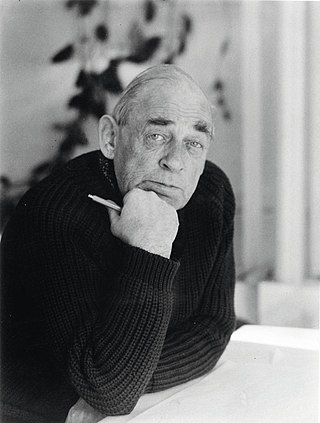
Hugo Alvar Henrik Aalto was a Finnish architect and designer. His work includes architecture, furniture, textiles and glassware, as well as sculptures and paintings. He never regarded himself as an artist, seeing painting and sculpture as "branches of the tree whose trunk is architecture." Aalto's early career ran in parallel with the rapid economic growth and industrialization of Finland during the first half of the 20th century. Many of his clients were industrialists, among them the Ahlström-Gullichsen family, who became his patrons. The span of his career, from the 1920s to the 1970s, is reflected in the styles of his work, ranging from Nordic Classicism of the early work, to a rational International Style Modernism during the 1930s to a more organic modernist style from the 1940s onwards.

Sir Norman Robert Foster, Baron Foster of Thames Bank, is a British architect and designer. Closely associated with the development of high-tech architecture, Foster is recognised as a key figure in British modernist architecture. His architectural practice Foster + Partners, first founded in 1967 as Foster Associates, is the largest in the United Kingdom, and maintains offices internationally. He is the president of the Norman Foster Foundation, created to 'promote interdisciplinary thinking and research to help new generations of architects, designers and urbanists to anticipate the future'. The foundation, which opened in June 2017, is based in Madrid and operates globally. Foster was awarded the Pritzker Prize in 1999.

Wembley is a large suburb in the London Borough of Brent, north-west London, 8 miles (13 km) northwest of Charing Cross. It includes the neighbourhoods of Alperton, North Wembley, Preston, Sudbury, Tokyngton and Wembley Park. The population was 102,856 in 2011.

Victorian architecture is a series of architectural revival styles in the mid-to-late 19th century. Victorian refers to the reign of Queen Victoria (1837–1901), called the Victorian era, during which period the styles known as Victorian were used in construction. However, many elements of what is typically termed "Victorian" architecture did not become popular until later in Victoria's reign, roughly from 1850 and later. The styles often included interpretations and eclectic revivals of historic styles (see Historicism). The name represents the British and French custom of naming architectural styles for a reigning monarch. Within this naming and classification scheme, it followed Georgian architecture and later Regency architecture, and was succeeded by Edwardian architecture.
The year 1935 in architecture involved some significant architectural events and new buildings.
Emanuel Vincent Harris, often known as E. Vincent Harris, was an English architect who designed several important public buildings in traditional styles.

Willem Marinus Dudok was a Dutch modernist architect. He was born in Amsterdam. He became City Architect for the town of Hilversum in 1928 where he was best known for the brick Hilversum Town Hall, completed in 1931. Not only did he design the building, but also the interior including the carpets, furniture and even the mayor's meeting hammer. He also designed and built about 75 houses, public buildings and entire neighborhoods.

Stalinist architecture, mostly known in the former Eastern Bloc as Stalinist style or Socialist Classicism, is the architecture of the Soviet Union under the leadership of Joseph Stalin, between 1933 and 1955. Stalinist architecture is associated with the Socialist realism school of art and architecture.

Municipal Auditorium is a multi-purpose facility located in Kansas City, Missouri. It opened in 1935 and features Streamline Moderne and Art Deco architecture and architectural details.

Sir Evan Owen Williams was an English engineer and architect, known for being the principal engineer for the original Wembley Stadium, and later Gravelly Hill Interchange as well as a number of key modernist buildings, including the Express Building in Manchester and the D10 and D6 Buildings at the Boots Factory Site in Nottingham.
Australian non-residential architectural styles are a set of Australian architectural styles that apply to buildings used for purposes other than residence and have been around only since the first colonial government buildings of early European settlement of Australia in 1788.

Bradshaw Gass & Hope is an English architectural practice founded in 1862 by Jonas James Bradshaw. It is Bolton's oldest architectural practice and has exhibited archive drawings in London and Manchester. The style "Bradshaw Gass & Hope" was adopted after Bradshaw’s death to incorporate the names of the remaining partners, John Bradshaw Gass and Arthur John Hope. As of 2022, the firm continues to operate from offices in Bolton.

Wembley Conference Centre was a conference centre in Wembley Park, London, England, that existed from 1977 to 2006, located next to Wembley Arena.

Sir John William Simpson KBE FRIBA was a British architect and President of the Royal Institute of British Architects from 1919 to 1921.
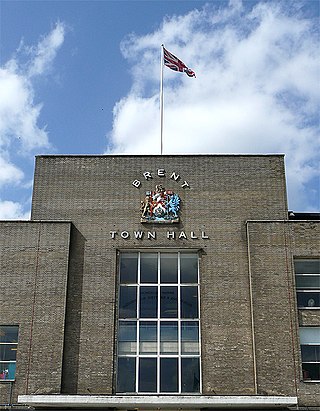
Brent Town Hall, formerly Wembley Town Hall, is a landmark building in Wembley Park in the London Borough of Brent, northwest London, England. The building is T-shaped, with a long façade on Forty Lane. The building was the seat of Brent London Borough Council until 2013 and is now occupied by the Lycée International de Londres Winston Churchill. It is a Grade II listed building.
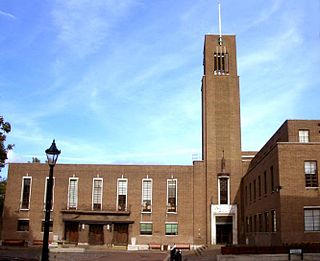
Reginald Harold UrenFRIBA was a New Zealand-born architect who worked in the United Kingdom for most of his career.
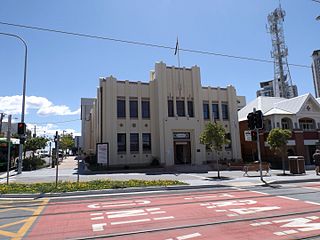
Southport Town Hall is a heritage-listed former town hall at Nerang Street, Southport, Gold Coast City, Queensland, Australia. It was designed by Hall & Phillips and built in 1935 by H Cheetham. It is also known as Gold Coast City Hall, Gold Coast Town Hall, and South Coast Town Hall. It was added to the Queensland Heritage Register on 5 October 1998.
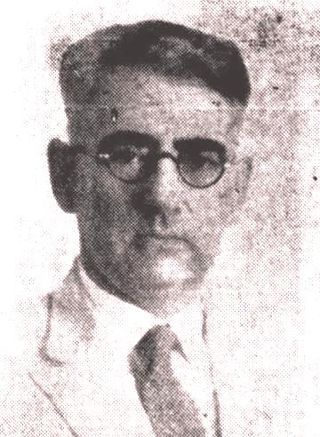
Cosman Citroen was a Dutch architect. He designed buildings in the Dutch East Indies including the headquarters of the Dutch East Indies Railway Company.

Brent Civic Centre is the headquarters of Brent London Borough Council, situated on Engineers Way in the Wembley Park area of the London Borough of Brent. It was opened in 2013, replacing the former headquarters at Brent Town Hall located a mile north on Forty Lane.

The Ahmedabad Town Hall, officially Sheth Mangaldas Girdhardas Memorial Hall, is an auditorium in Ahmedabad, India. It is named after Mangaldas Girdhardas, a textile industrialist.
References
- ↑ "Selected to design Wembley town hall". The Guardian. 22 May 1935. Retrieved 15 May 2023.
- ↑ "DSA Architect Biography Report". Dictionary of Scottish Architects. Retrieved 25 November 2022.
- ↑ Metroland short course notes, Twentieth Century Society, 2008
- ↑ Architect and Building News, 24 May 1935
- ↑ The Architectural Review, in January, 1940.